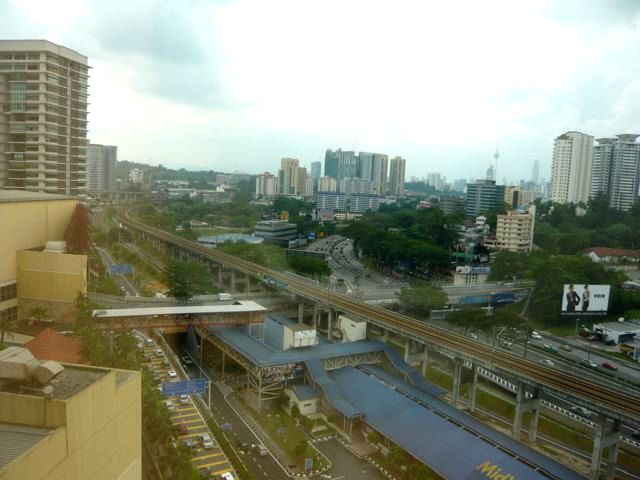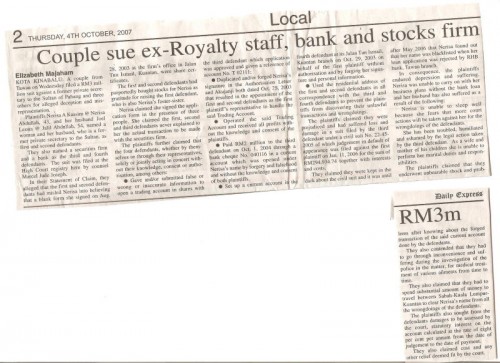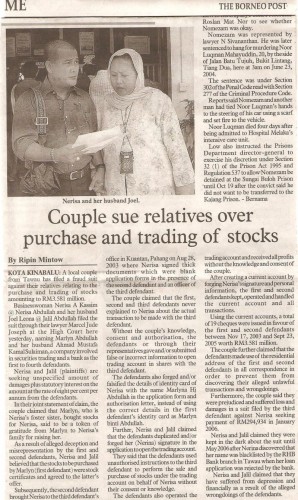Corporate doublespeak: subsidies vs “incentives”
From People Power to Pedal Power
Why the generous subsidies for IPPs?

Oil price hike protest in Ipoh (Source: Unknown; forwarded via email)
So Petronas and the Malaysian government says subsidies distort the market. Of course, the withdrawal of subsidies will encourage conservation of a scarce resource – which is a good thing. It might even reduce pollution and congestion. Roads were noticeablly less congested in parts of Penang and KL today. Traffic on the Penang Bridge heading to the island at 5.20pm – peak time – was smooth; the usual bottleneck after the toll plazas, as the mutiple lanes narrow down to two lanes, was gone. But has the government given much thought to the impact of the removal of oil subsidies on the poor – and even large segments of the middle-class, who are rapidly moving down to the ranks of the poor in terms of real purchasing power? One key question has not been answered: why a sudden complete removal and not a gradual phasing out? Come on, tell us how much profit Petronas made for the year ended 31 March 2008. The figures should be available by now, even if the annual report isn’t ready.Would you like to see this in your city?

A modern tram in Grenoble, France – Photo credit: Wikipedia (copyleft)
The tram initiative is building up momentum. So far, 25 29 30 31 bloggers and websites have signed on to the campaign. Civil society activists have articulated their views too. Here’s what some people are saying: Heritage writer Khoo Salma Nasution:Heritage writer Khoo Salma Nasution noted that the Penang Island Municipal Council was the first local government to introduce electric trams in the inner city in the early part of the last century. “People think the tram is a thing of the past, but they are wrong because it is actually the thing of the future,” she said. “It is clean, energy saving and user-friendly not to mention fast, efficient and also cheap.”
More on the mysterious oil subsidies
At least RM500/mth to use the second Penang bridge
 Now that oil prices have gone up by 41 per cent and diesel by even more, our planners should scrap the proposed second cross-channel road link for Penang.
If the RM4.8 billion second Penang bridge (all 24km of it, 17km over water) sounded like a bad idea before the oil price hike, today it sounds like a terrible idea in the light of higher fuel prices.
Let’s try this out for size to see how much it will cost the average commuter every month to use the bridge.
Now that oil prices have gone up by 41 per cent and diesel by even more, our planners should scrap the proposed second cross-channel road link for Penang.
If the RM4.8 billion second Penang bridge (all 24km of it, 17km over water) sounded like a bad idea before the oil price hike, today it sounds like a terrible idea in the light of higher fuel prices.
Let’s try this out for size to see how much it will cost the average commuter every month to use the bridge.
Time to bring back the trams
Excerpt from Reuters:
“It will be postponed if the demand does not grow at the rate that it should grow,” (Petronas) Chief Executive Mohd Hassan Merican was quoted as saying by state news agency Bernama.
He added: “If the rate is reduced from six percent (demand growth annually) to four percent, it will be extended by three to four years to 2014 or 2015.”
Subsidy? What subsidy? Aiyah, I don’t understand-lah…
It’s a jungle out there! Oil price hike madness…
What are they doing on the Penang Bridge centre-span?
High above the Penang Bridge
For the longest time now, there has been major ongoing work on the three-lane centre-span of the Penang Bridge. The work seems never-ending. Many motorists are puzzled about the long-term closure of the far left lanes on the centre span.
Petronas’ RM600 billion profit: Where has it all gone?
Second Penang bridge cost soars to RM4.8 billion

Traffic jam on the Second Penang Bridge in 2020? Toll $$$ for UEM
In July 2007, the estimated cost of the second Penang bridge was RM2.7 billion.Urban planning gone crazy
RSS feed addresses
Blogger Power drives Penangites for Trams Campaign
Nerisa and Jalil’s quest for justice
From Sabah comes an interesting case. A couple from Tawau, Nerisa A Kassim @ Nerisa Abdullah and her husband Joel Leona @ Jalil Abdullah, have filed a RM3 million suit against a female relative of Nerisa’s and a former private secretary of the Sultan of Pahang for alleged deception and misrepresentation. The female relative, who is trained as an accountant, is the daughter of Nerisa’s mother’s niece; both she and Nerisa had been brought up as sisters by Nerisa’s parents in Sabah.
They allege that Nerisa was duped by Nerisa’s relative and the former secretary into signing a blank form, purportedly to buy shares for Nerisa. The couple allege that the securities trading and bank accounts that were opened in Nerisa’s name were later used by the relative and the former secretary to move large sums of money – including a cheque for RM2 million – without her knowledge.
The couple are also suing the securities firm and the bank, where the accounts were opened. Nerisa claims she only came to know about the alleged deception when she applied for a bank loan with a different bank in Sabah only to be told she had been blacklisted for the earlier share-related transactions. A judgment in default amounting to RM294,934 in favour of the securities firm in Kuantan for those suspicious transactions had been sent to an incorrect address in Tawau, which meant Nerisa might even have been declared bankrupt without her knowledge had she not been alerted by the rejection of her bank loan application.
Here is a Daily Express press report giving more background to the case (click on image to see enlarged version):
And another report from The Borneo Post (click image to enlarge):
As oil prices soar, we build more infrastructure for cars… Hello!
Trains, Buses and Bikes, Oh My!
Last week, Isaiah reported on the 7% increase in mass transit ridership, and also how limited that increase is. Because the Bush administration did nothing to make mass transit more convenient and accessible, many Americans who want to quit paying for high-priced oil don’t have that choice.
It’s not just mass transit. It’s bikes too.
Today, my local paper headlined “Bike Sales Rise With Gas Prices. In fact, local outlets across the country are reporting the same spike with bikes. And interest seems to be growing beyond the stereotypical hippie bike messenger. Read more
New feed details
This blog is now hosted on a new server…
The Ghost of Penang Future: State govt should establish “green” credentials fast
Cover-up job: The rape of hill-slopes continues (Photo credit: Rhino)
Last Friday, another mud slide struck Penang on the stretch of road between Tanjong Bunga and Batu Ferringhi. It was not surprising given the sort of hill-slope development taking place. This one occurred in the vicinity of the Ivory building project. You can see from this picture the sort of hill-slope development taking place in the northern part of the island. They must be crazy if they believe those plastic sheets will stop erosion. In the event, tractors had to be called in to clear the mud from the road. And traffic was backed up for quite a bit. Here’s what it looked like even after the mud had been cleared from the road.Penang turning into one huge parking lot (Photo credit: Rhino)
Not much fun for all those motorists caught in the jam. Yesterday, it rained again, and one concerned resident in Tanjung Bunga told me the sea looked a mess of angry brown – probably from the silt. If you are flying above Penang Island, you can easily notice the water off the immediate coast of Penang looking a murky brown before it blends into the stunning deep blue and green hues of the Andaman Sea further north. It’s time for the Penang state government to assert strongly that it will defend the environment and ease traffic congestion with more sustainable solutions. It has to rein in developers and tell them in no uncertain terms that the rape of the island and its beaches and hillslopes is not on. But I fear that politicians, being politicians, will plan only for the next five years – instead of looking for more sustainable long-term solutions. Such short-term solutions are aimed at winning again in the next general election. This means atracting more investors (never mind what kind) and promoting “development” (with just lip service to protecting the environment) and quickly building bridges and highways and outer ring roads to ease traffic congestion on existing roads. This is what the state government is doing by supporting the second road bridge etc. But the problem is these short-term solutions might not be in the best interests of Penang and its people in the longer term, say beyond 10 years. I dread to think what the traffic on the island will be like with five lanes of incoming traffic pouring into the island – three lanes from the expanded Penang Bridge and another two from the proposed second bridge. As it is, Green Lane and Scotland Road are congested during peak hours. What happens when the second bridge too gets congested? We build a third bridge? And when that gets congested too, then what? Only then do we think of more sustainable solutions? How will the narrow streets of George Town ever cope until then? And considering that the oil price is now over US$130 plus per barrel and rising, how many ordinary people will be able to afford commuting on these bridges (let’s not even think of the tolls!) in say ten years? So why not think of the sustainable solutions now – instead of deferring that to the future, when it would be too late? Shouldn’t we be laying the groundwork now to move away from private vehicle ownership? We should be shunning – not embracing – infrastructure projects that will lead to more road congestion and entrench private vehicle ownership. Instead, we need to be looking at more sustainable and cost effective public transport solutions, perhaps a cross-channel rail link integrated into a comprehensive bus, guided-bus, and street-level rail system. It was only last week that Penang civil society groups called on the state government to come up with a transport masterplan for the whole state before plunging into irreversible mega projects that would have long term damaging repercussions for the state. So it is a huge disappointment to see the Penang state govt working closely with the BN federal government to permanently entrench private vehicle ownership through bridge infrastructure – even before we can work out a sustainable transport masterplan, as recommended by the leading civil society groups in the state. Can’t we, at least, wait a few months until a progressive transport masterplan is prepared? One Penangite, concerned about the environment and looking at the hasty arrangements being struck, said, “This is a black day for Penang. Is this government any different from the BN government in terms of the direction it is taking us?” You can see how much the road congestion – even now – has already drained the charm of the island and sapped it of its vitality. Actually, the new Penang state government has an enormous reservoir of political goodwill from the people following its overwhelming mandate in Penang – which it should not squander on the wrong solutions. If it was to lay its cards on the table and tell the people, this is the new direction we would like to take towards a more sustainable Penang that would be a model for other Asian cities – much like Curitiba is a model for South American cities – it would create such a buzz of excitement and enthusiam among Penangites who value their environment. Many would volunteer their services to sit down and conceptualise a green and sustainable Penang we could all be proud of. This requires a willingness to come together to plan, to engage with the most progressive urban planning and public transport experts (those without vested interests in transport infrastructure firms or projects) and to listen to public views. George Town now is still one of the most liveable cities in Asia. But, at this rate, for how much longer? Even if we are thinking only of attracting investors, the “liveability” of a city is a major “pull” factor. Would investors – would any Malaysian, for that matter – really want to live in a polluted, congested island that is no different from any other anonymous, overcrowded city. Penang today is at a crossroads. We can choose to go down a more sustainable path towards a green heritage city with parks, lakes, pedestrian malls, trees, shrubs, flowers, organic vegetable farms and street-level rail systems such as trams and guided buses. Or we can crawl down the congested highway of heavy, unsustainable infrastructure projects that will turn Penang into one huge parking lot shrouded by smog and silt. The choice looks easy to me. We will live with the consequences of our choices now for generations to come – generations who might one day curse us for the choices we make now. So choose wisely with future generations – not just the next general election – in mind. We need long-term strategies formulated in the best interests of the people of Penang – not politically expedient short-term solutions.




